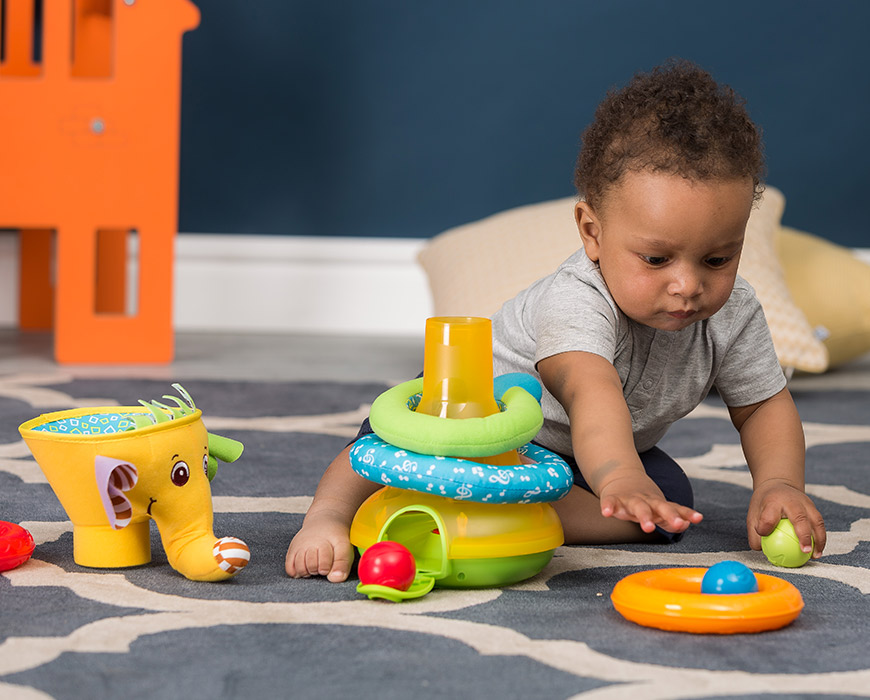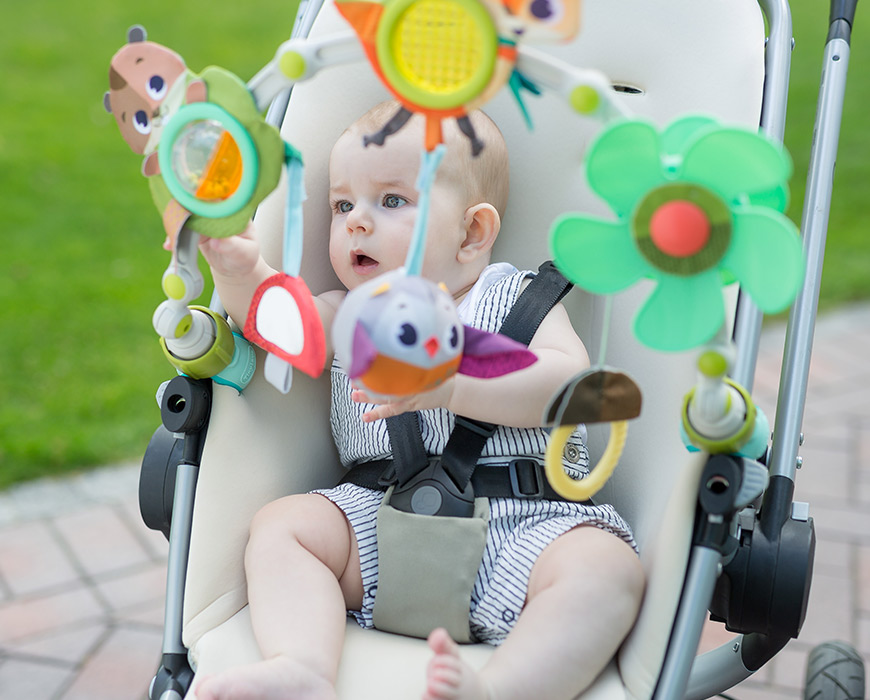How Di I Know if My Baby Is Coordinated

Gaining the ability to touch on what you come across
After discovering their hands, babies need to learn that they can activate them, make use of them Ten-calendar week-onetime Emma lies comfortably watching the toys of her activity gym hanging higher up her. She is focused on the colorful toy hanging inside attain of her hand. She looks at the toy for a few seconds and so suddenly, puts her manus out and swings it towards the toy and … misses. Emma doesn't give upward. Pushing her hand out once again, she seems to exist assessing the distance and and then she strikes again. This time her manus hits the right spot and the toy swings happily dorsum and forth. A wide smiling spreads across Emma's face. Emma is busy developing the coordination between her eyes and her hand. She is trying to learn how to bring her hand directly to the object she is focusing on. It'due south difficult for usa, as adults, to sympathise the significance of the concept of "hand-eye coordination" considering we take this coordination for granted. When we look at an object and desire to touch it, nosotros don't hesitate fifty-fifty for a moment, and we don't requite a second idea to the task at hand. Our hand moves as though of its own in the direction of the object, and closes exactly at the right place. This obvious action is the result of many months of learning during the first year. Allow's "become back" to this period for a moment and try to understand the procedure that a tiny babe has to go through in order to learn the obvious coordination between hand and center.
-
Discovering Hands
Newborns don't associate what their eyes come across with what their easily practice. Often their eyes look in one direction, while their hands motility randomly in some other. Babies can't motility their hands toward an object they see. Furthermore, they are yet unaware that these easily, which belong to them, are function of their bodies. Most of the fourth dimension their hands are exterior of their vision, and they are not even aware of them. Babies first have to discover that they have hands. This commonly happens at about six to eight weeks. Babies discover their hands through touching. They grab one hand with the fingers of the other hand. They pull on them, and open and close their fingers. At this stage, their movements are usually random; they don't even so lift their hands in front of their optics to intentionally look at them. At six to viii weeks, objects that make dissonance, such as a rattle, should exist put into baby's hands. Newborns are built-in with a gripping reflex, automatically clasping their easily around an object placed in them -- they will therefore also grasp a rattle put in their hands. Then, when they move their hands randomly, they hear the rattling noise and look for the source of the sound with their eyes. When they observe the rattle, they will also discover the hand grasping it. Lite toys that tin can be held and make sounds when shaken, are known to be pregnant during the weeks that follow. They draw babies' eyes and attention to what they are belongings in their hands. They help babies plant the connection between themselves and their hands. When they accept learned to intentionally bring their hands within their vision, their hands get their virtually fascinating toy. They don't take their eyes off of their hands; they moving ridge them in front of their faces, examine them in amazement and play with them endlessly.
-
During the first twelvemonth, babe'south oral cavity plays an of import office in his development. Babies examine, explore and discover the earth around them with their mouths. Later, from about six months, their easily also join in and they begin to examine the objects that they are holding
-
I Know How to Strike
After discovering their hands, babies need to learn that they tin actuate them, make utilize of them. When your infant reaches three to four months-of- age, it's important to hang toys that can be batted or struck,, above where she lies. When babies prevarication on their backs nether such a toy, an interesting process begins to have place. They focus their eyes on the toys and look at them gleefully. At the same time, they will move their hands or feet randomly until suddenly something wonderful takes identify: their paw will touch on a hanging toy and the toy will swing back and forth. After several such random strikes, they volition brainstorm to sympathise that they control the process, and the random strikes go more and more intentional. If babies could describe their experiences verbally at this stage, we would surely hear them say something similar: "Hey, am I doing this wonderful thing? Do my hands have the power to practise something so keen? Maybe I'll try information technology again." Gradually babies learn to straight their easily and bring them to the objects that they are looking at. This is when hand-eye coordination is established.
-
To Touch and to Concord
In one case hand-eye coordination has improved and is established, babies are not happy just to bat at a toy. They want to touch the objects and then they begin to assess the altitude between themselves and the object that they want to affect. They move their eyes from their hands to the object, and dorsum again, many times and only then, one time they have assessed the distance, they put their easily out and bear on the object. Gradually, this process becomes more accurate and they can stretch out their hands directly to the object and touch it without hesitation. At about v to six months, babies can bring their hands directly to an object within reach, and have even learned to grasp at but the right moment and … grab and hold on to the desired object.
When babies begin to desire to touch objects and hold them and are non satisfied with just looking at them, it is of import to place toys that don't fall over within their reach. They need to have something that doesn't move hanging above them, so that they tin reach out and impact without it swinging and slipping away all the fourth dimension. At this stage toys that move away can frustrate and disappoint the baby. At present y'all can directly train your infant to intentionally touch on and grasp objects: Hold an middle-catching toy in front of your baby, within reach, and wait patiently until he reaches out and touches it. Practice non move the toy closer. Endeavor holding the toy at a fixed distance and wait patiently until your baby's mitt reaches information technology. Your baby will gradually become quicker and more skilled at doing then, until he succeeds in reaching out straight to the toy. You should concord out objects for your baby to touch while he is in dissimilar positions, then that he can improve this ability. Yous can shake a rattle within hands-achieve while your baby is lying on his back or on his breadbasket so that he will have to stretch in social club to accomplish information technology. You tin likewise milkshake the rattle behind his back while someone else is belongings him, and then that he will have to plow around and stretch his paw out in another direction.
-
After discovering their hands, babies demand to learn that they tin activate them, make use of them. When your infant reaches three to four months-of- age, it's of import to hang toys that tin be batted or struck,, above where she lies
-
Achieving Hand-Eye Coordination
From the age of about iv months your infant will first bringing the object he is property in his hands to his mouth. During the kickoff year, baby's rima oris plays an important office in his development. Babies examine, explore and observe the earth around them with their mouths. Later, from about half dozen months, their hands also join in and they begin to examine the objects that they are holding – to touch, tap, rub, stroke, clasp and and so on. By now, hand-heart coordination is already established, and babies can motility on and begin to improve their fine motor movements and skills,-- the coordination betwixt both hands, and their manus-eye coordination involving more than difficult tasks. Hand-eye coordination continues improving over many years.
Imagine what remarkable coordination between optics and hands has been achieved by a pianist sitting at his pianoforte. He glances at the sheet of crowded notes, moves his glance quickly from the canvass to the pianoforte and back again, and hits his fingers precisely, and with perfect coordination, on the keyboard. This is so quick that it is sometimes difficult to run across his hands, which have become a blur of movement. This skill requires specially sophisticated and well-adult hand-eye coordination. However, every day actions such every bit bringing a spoon of soup to our mouths, belongings a pen and drawing a circle or threading a needle, also require proficient hand-middle coordination. Your baby, toddler and child will learn these tasks through hard work and daily exercise.
-
Whatever advice and information provided in this website is given as suggestions only and should not be taken equally a professional medical diagnosis or stance. We recommend you likewise consult your healthcare provider, and urge you to contact them immediately if your question is urgent.
Source: https://www.tinylove.com/us_en/articles/development-of-hand-eye-coordination

0 Response to "How Di I Know if My Baby Is Coordinated"
Post a Comment